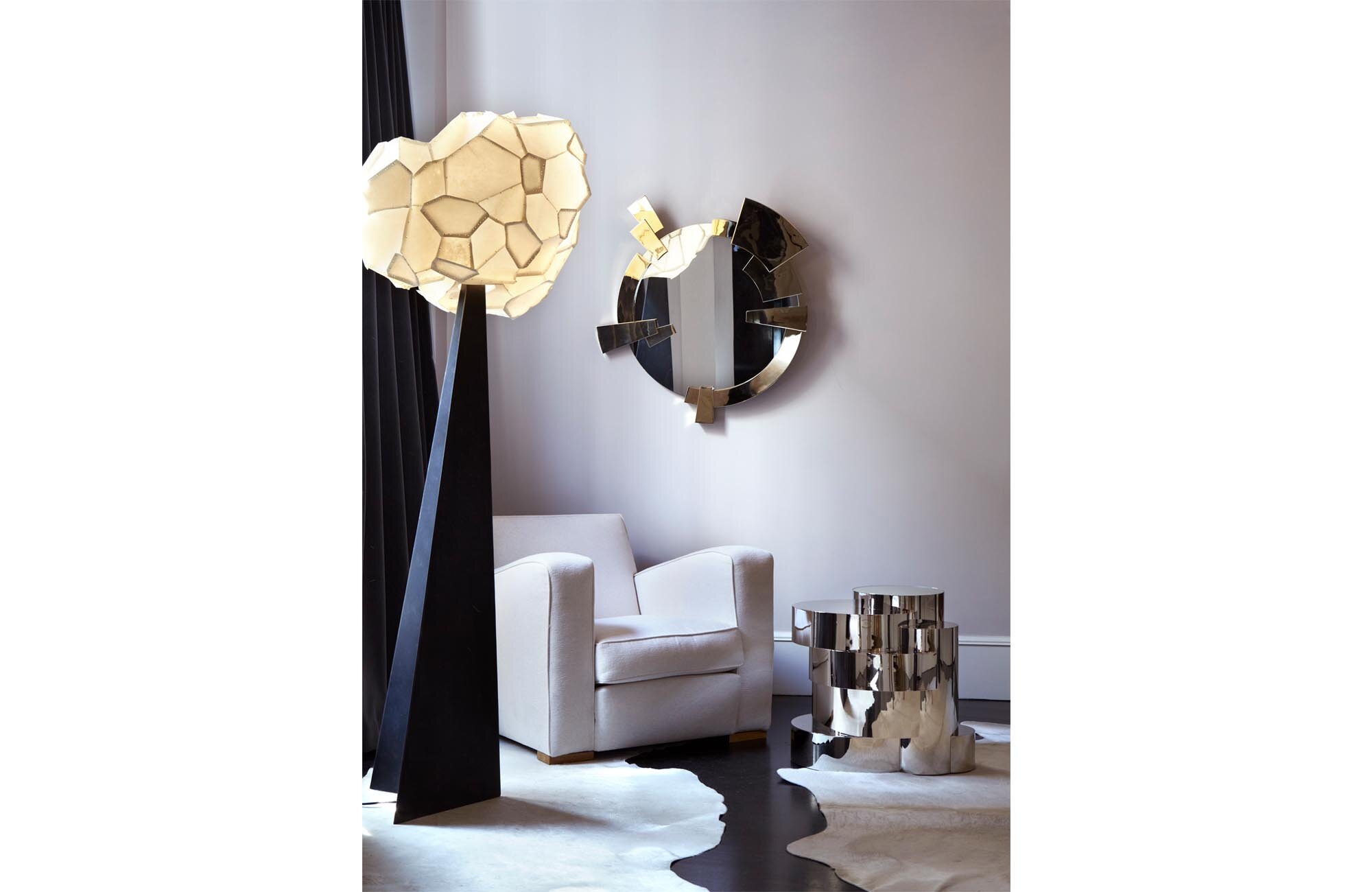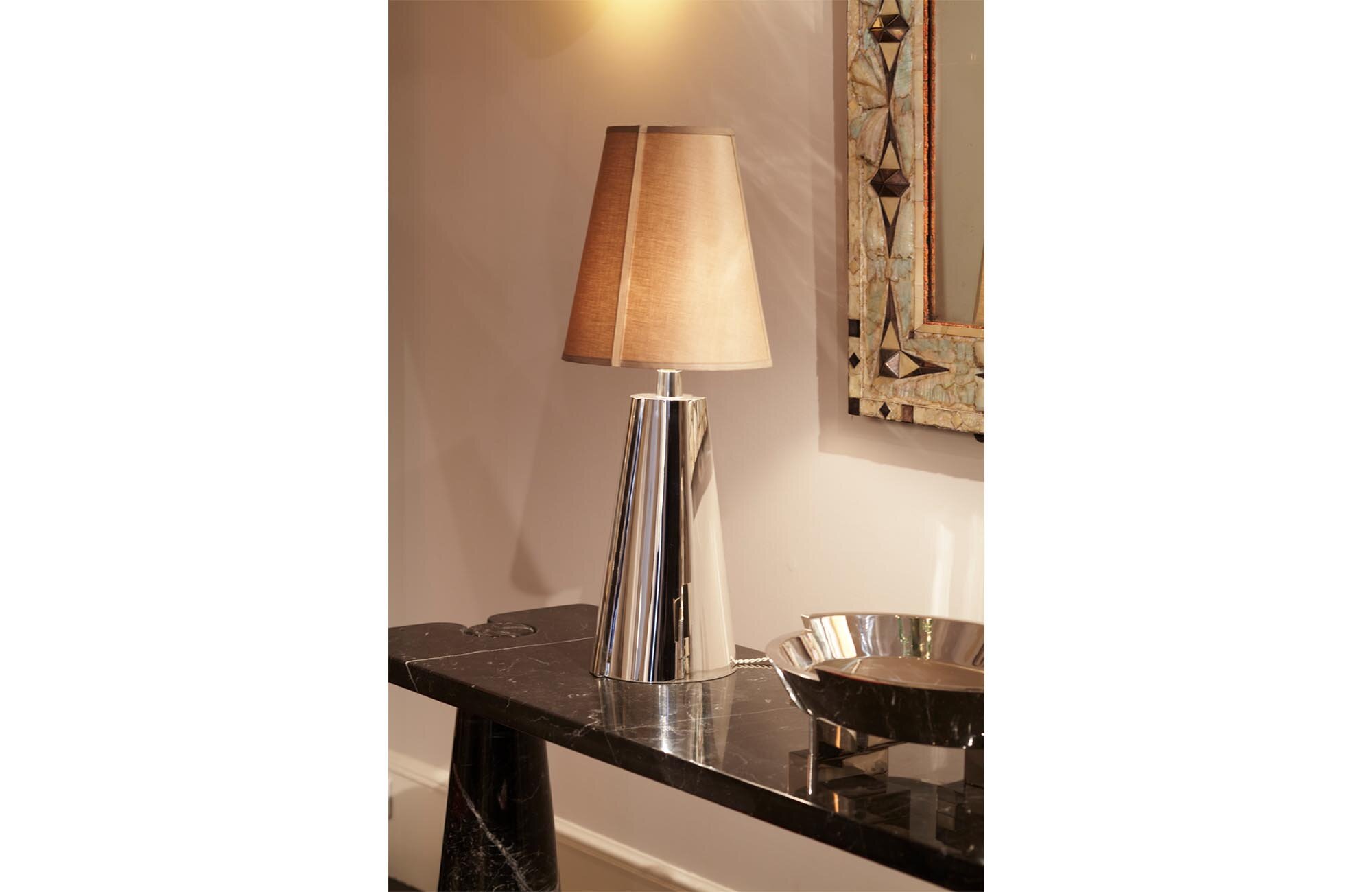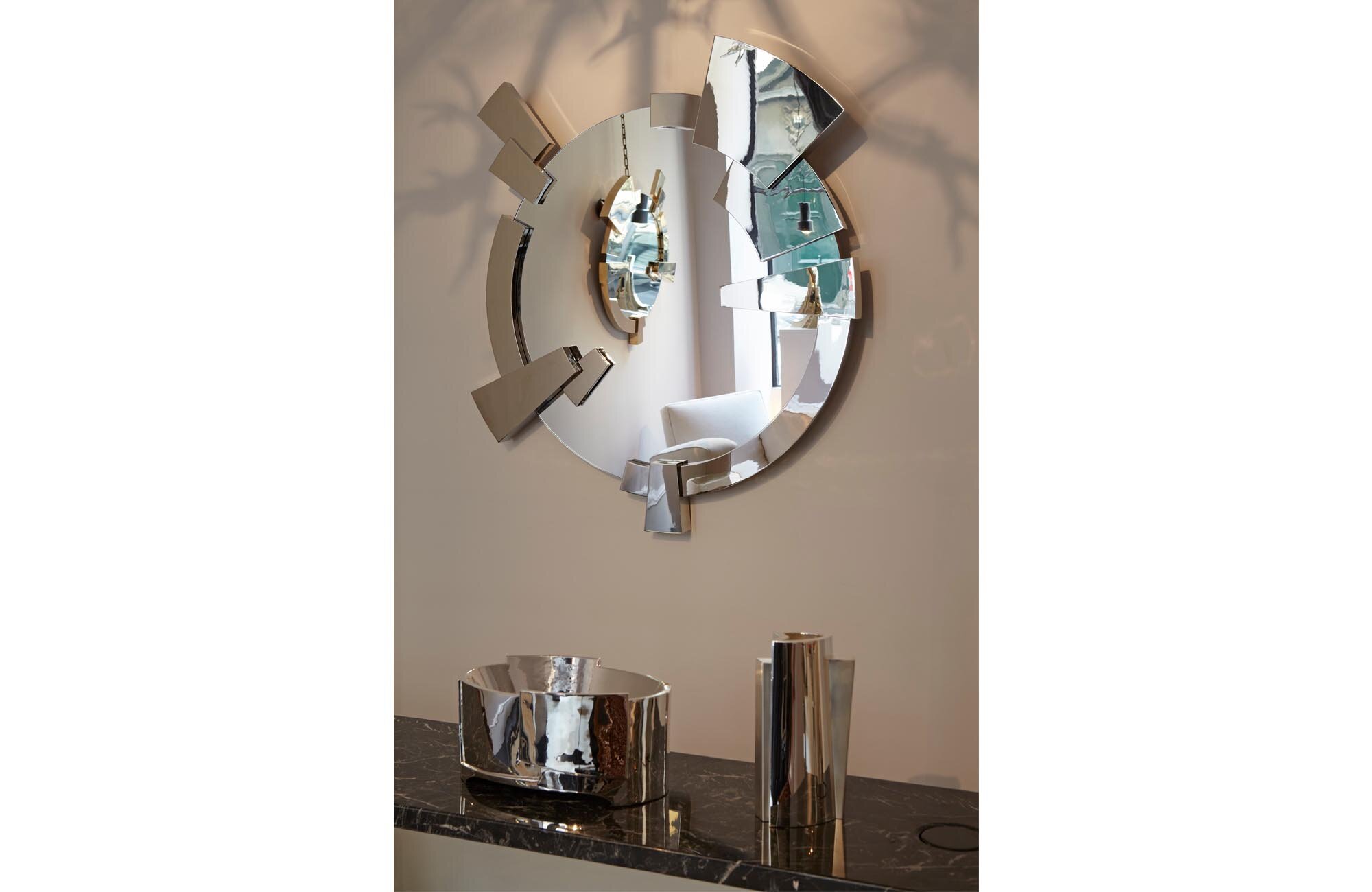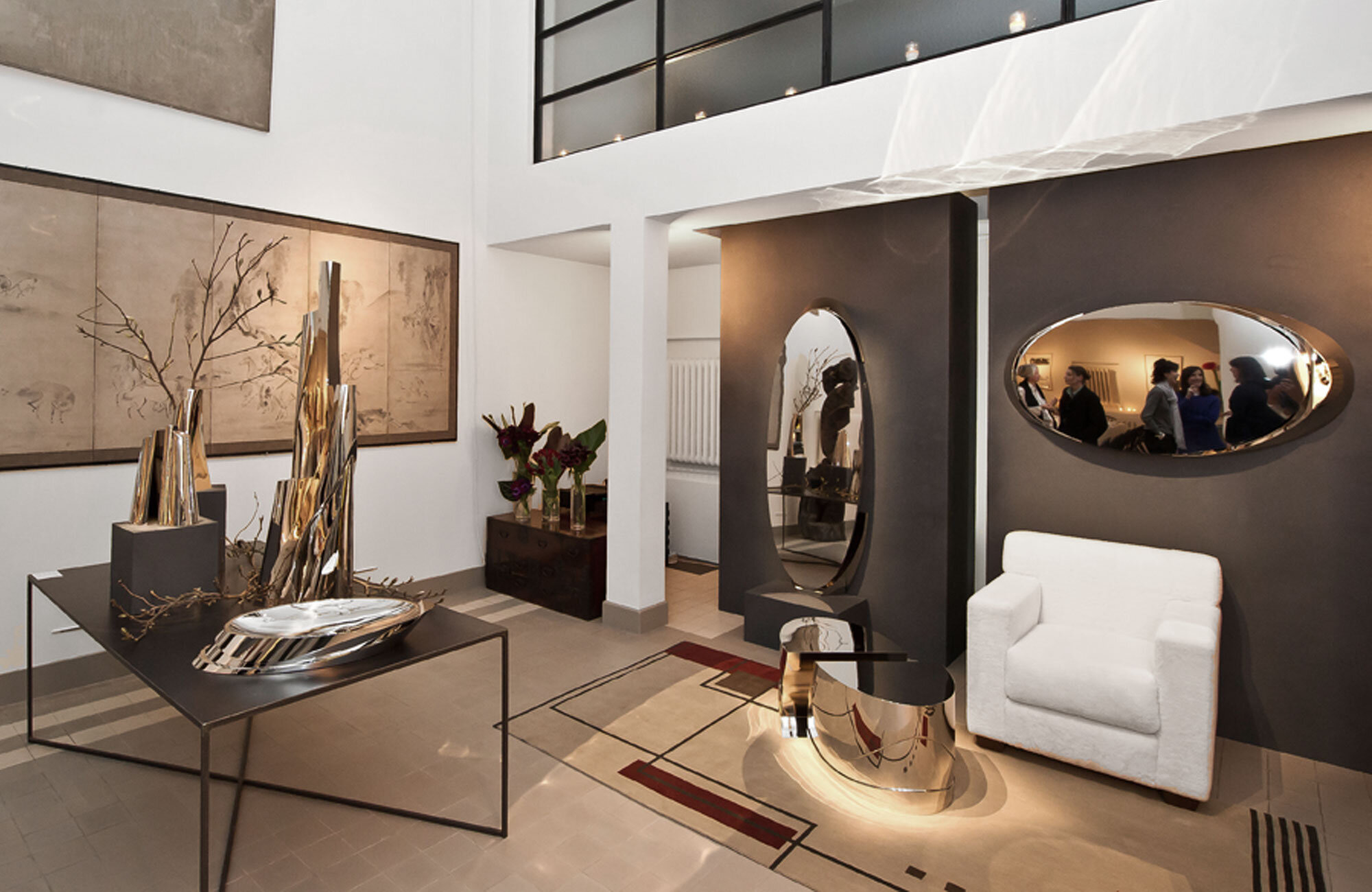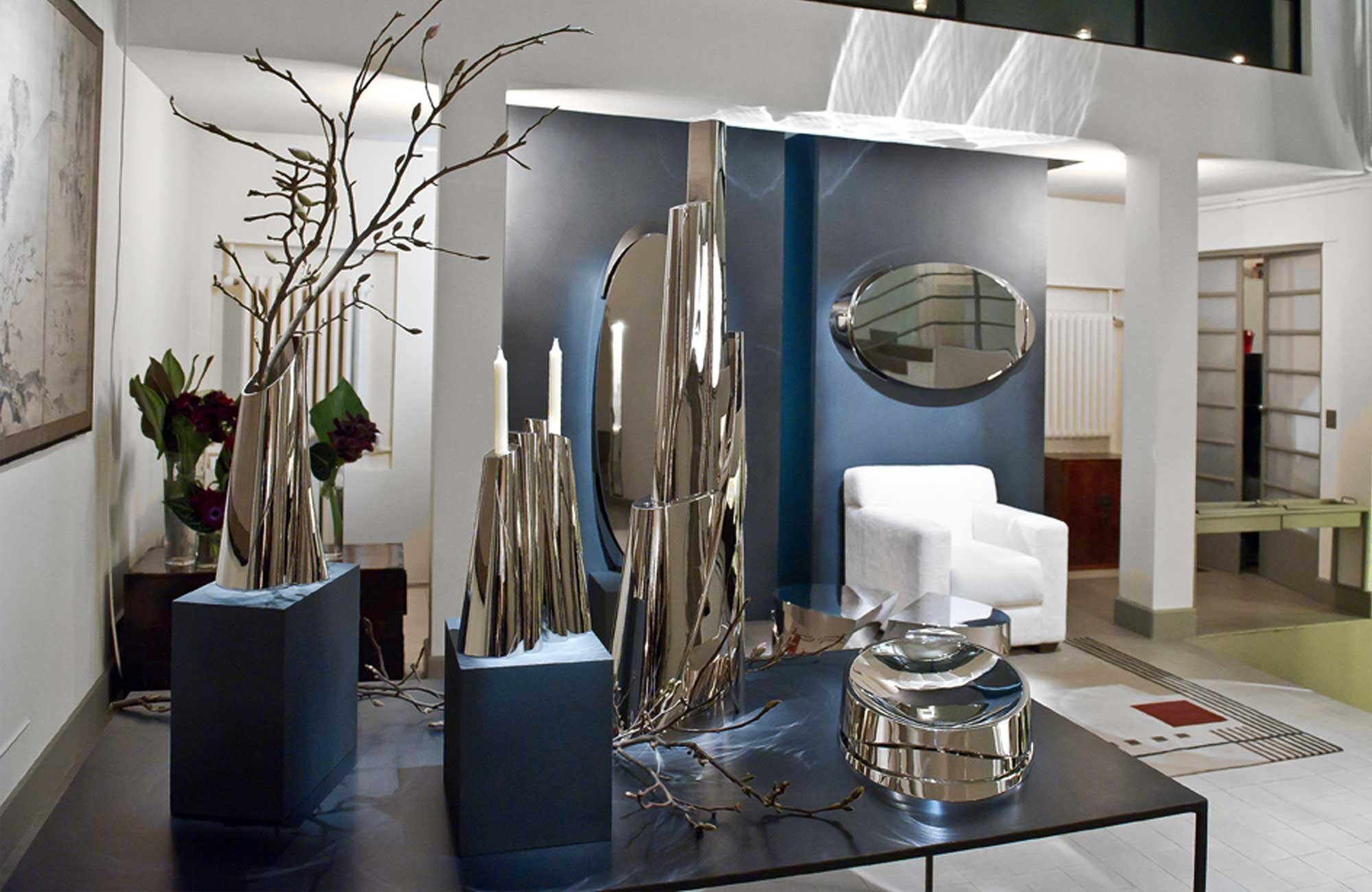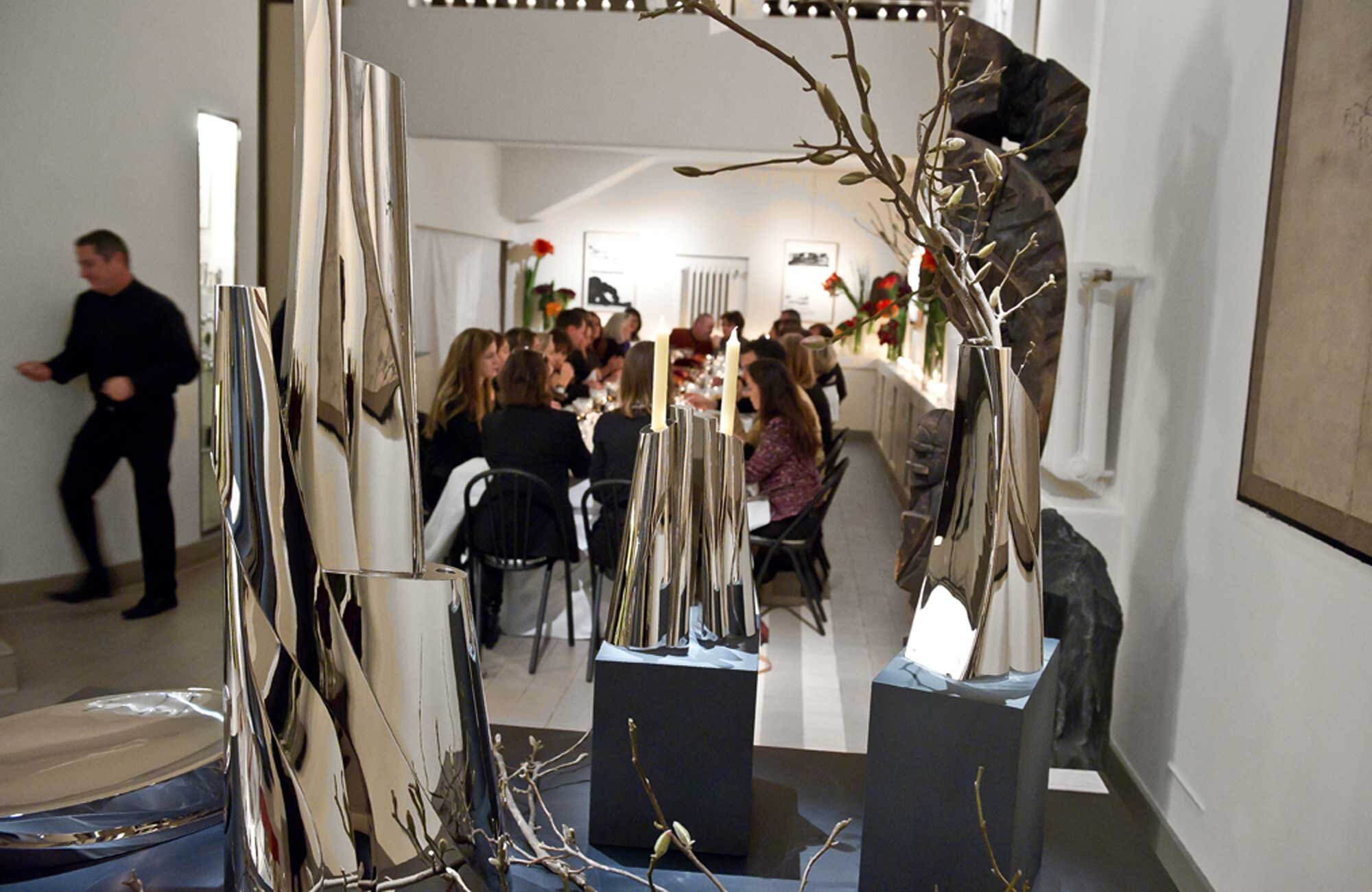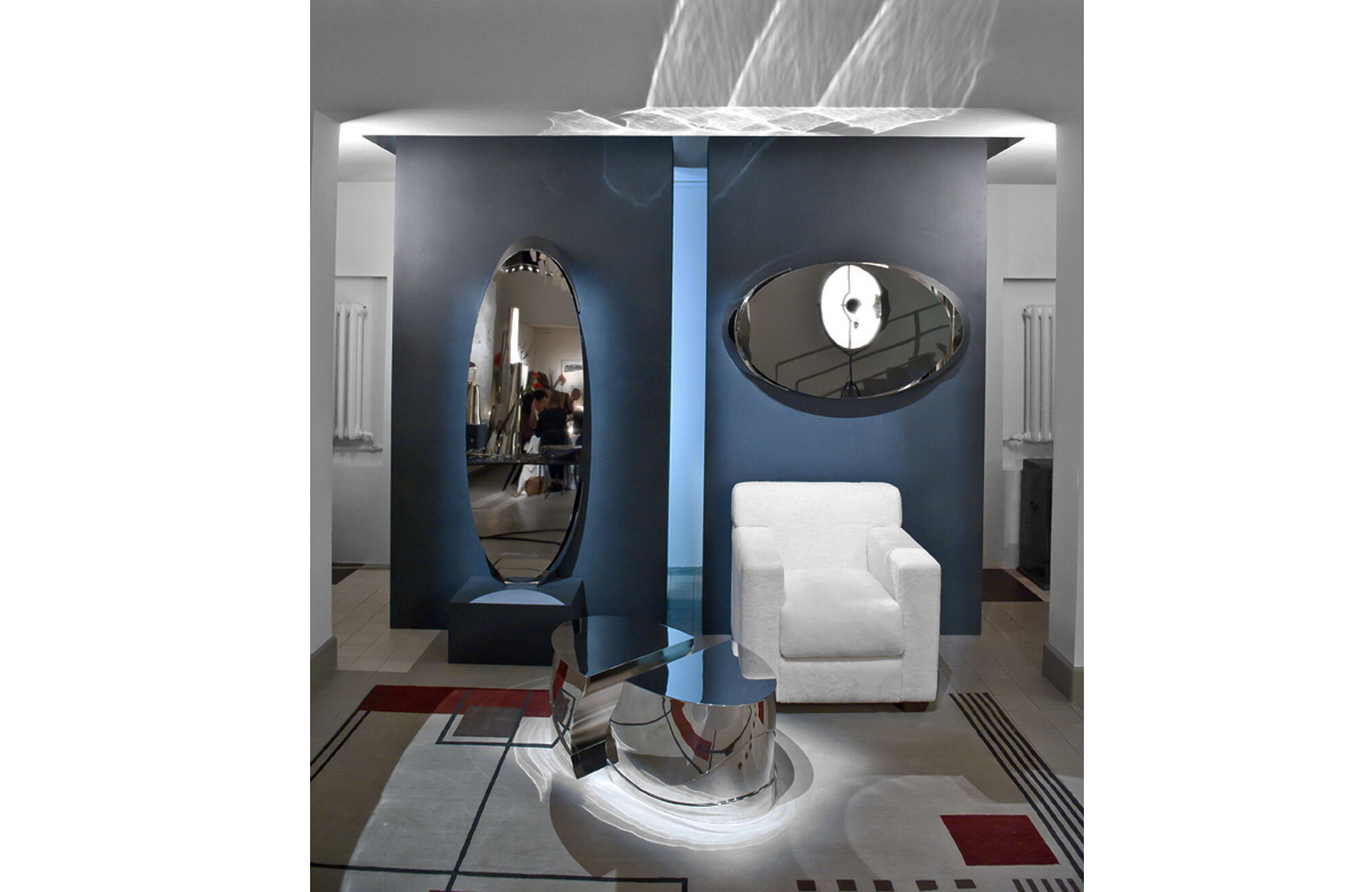
ARGENTUM PROYECT
ARGENTUM PROYECT
2023
Ghada Ahmer
Nacho Carbonell
Ross Lovegrove
Peter Marino
Campana Brothers
Share this
PRESS RELEASE
Puiforcat, Historical Silversmith of a Contemporary Lifestyle:
For nearly two centuries, the house of Puiforcat has dressed the finest tables and served as the silversmith of choice for connoisseurs and collectors of exceptional objects. Sterling silver cutlery, serving pieces, trays, centrepieces and candelabras are crafted in its workshops with the unique savoir-faire its artisans have cultivated since the nineteenth century.
In addition to its masterful crafting of metal and other precious materials, the house is also known for its consummate sense of simplicity and elegance, which it owes in large part to Jean Puiforcat. Master silversmith and fourth-generation member of the Puiforcat family, Jean headed the company in the 1920s. Guided by the Art Deco movement and the Union des Artistes Modernes, he forged a distinctive sculptural and geometric signature associating basic shapes (cube, sphere and cone) with rigorous lines. A true pillar of his identity, this style, which combines harmony and the quest for beauty in utility, is now still one of the foundations of the house of Puiforcat. The same goes for its tradition of collaborating with top designers from every era.
Renewing its tradition of fine decorative silverwork, Puiforcat reproduced a visionary Jean Puiforcat lamp and clock in 2012, emblematic pieces that stand out for their design and exceptionally precious materials. The house is pursuing this initiative in 2013 with the introduction of Magnificat Puiforcat. This contemporary line features truly monumental decorative objects signed by two designers and silversmiths: Juan and Paloma Garrido. With the Magnificat Puiforcat collection, the house reaffirms its longstanding devotion to the world of decoration.
Magnificat Puiforcat, New Collection of Sculptural Pieces:
Borrowed from Latin, the lyrical name of this new collection represents Puiforcat's everlasting quest for excellence. With Magnificat Puiforcat, the master silversmith has not only drawn from the etymological idea of "magnificence" by offering unprecedented, monumental decorative objects but has also magnified its expertise.
Composed of seven exceptional pieces, this new, resolutely contemporary line stands out through its size and its uses, through its style and the virtuosity with which each piece is crafted. An extraordinary declarative collection, Magnificat Puiforcat draws its inspiration from the sculptural, geometric and timeless spirit of Jean Puiforcat. As the strong edges and polished surfaces of Patrick Jouin's Zermatt knife come alive in the light, each piece marries taught lines with smooth curves in a skilful architecture of flexible geometry, echoing the Puiforcat universe. "The combination of verticality and elongated surfaces lends a feminine elegance to the pieces, which nevertheless remain very masculine in their volume and lines," explained Juan and Paloma Garrido, responsible for these creations. "Horizontal and vertical lines, as well as the intertwining curves, continuously play with the eye to create a sense of movement.”
7 Objects, 7 Artists, 7 Techniques:
Each of the seven pieces in this unprecedented collection requires four to ten weeks of handcrafting by expert artisans. Seven different artists, each of whom masters various traditional silversmithing techniques (cold forging, hammering, planing, assembly, welding, deburring, polishing, chiselling), intervene in turn to achieve a perfect finished product. The seven objects are crafted in nickel-plated brass, which was chosen for its warm tones, visual quality and adaptability for use, as it does not rust. This material is also conducive to mirror-polished finishes of exceptional quality. Each piece is available upon request in a limited series of 20 numbered copies.
Juan & Paloma Garrido, Magnificat Puiforcat Designer-Silversmiths:
When Spanish silversmith Damian Garrido passed away in 2002, he left behind a great legacy. His children, Juan and Paloma, became heirs to a long tradition of working "La Plata" using a typically Spanish method of hammering linked to the conquest of the New World and its silver mines. Trained from childhood in the silversmith's techniques at the family workshop, the brother and his younger sister were nourished with their father's passion for the discipline and its leading innovators, including Jean Puiforcat. "As we learned, we sought inspiration in the work of artists of times past that we discovered in books and museums. Among them, Jean Puiforcat was always a model and an extremely important reference in our creative process," explained Juan and Paloma. With their technical mastery, their aesthetic culture and their intimate link to the history of the trade, the two heirs have for the past ten years established a unique contemporary register, whose main features resonate with the house of Puiforcat.
The Garridos' formal language easily communes with that of Puiforcat: the constant pursuit of balance and harmony among arcs, curves and structured lines; a sense of composition; and bold geometric combinations. The house thus naturally called upon their talent to imagine the declarative Magnificat Puiforcat collection. "To create this line, we drew from the work of Jean Puiforcat and then looked to incorporate a new architectural dimension," said Juan and Paloma. “It took a year to develop this collection, as we sought to offer shapes that are entirely new to the world of silversmithing.”
The House of Puiforcat:
Founded in Paris in 1820 by Jean-Baptiste Fuchs and his two cousins Émile and Joseph-Marie Puiforcat, the family company owes much of its fame to Jean Puiforcat. Member of the fourth generation of the family, Jean would go on to write the most beautiful pages of the company's history almost a century after its creation and would propel Puiforcat to the forefront of modern silversmithing. Under the influence of his father Louis-Victor Puiforcat, the workshop had by the end of the nineteenth century achieved a quality of the highest order, and had begun reproducing 17th-century masterpieces. Jean was named master silversmith in 1920. Immersed in the wave of artistic renewal that came to characterise the period between the two world wars, he was one of the founders of the Union des Artistes Modernes in 1929 and came to befriend René Herbst, Le Corbusier, Charlotte Perriand and Pierre Charreau. Fascinated by sculpture, Jean Puiforcat invented a revolutionary formal language that aligned form with function.
Architectural shapes, clean lines, meaningful simplicity, lack of embellishment and the blend of sterling silver and other precious materials such as exotic wood, hard stones and shagreen – Jean's spare, Art Deco-inspired style is the foundation of fine contemporary silverwork. Often reproduced, his work continues to impart a distinct spirit to the house's contemporary collections. Since coming under the wing of the Hermès Group, Puiforcat has used its truly exceptional savoir-faire to both reproduce the finest pieces of its heritage and to imagine tomorrow's classics alongside great contemporary designers. Beyond its unrivalled expertise in the art of tableware, the house now aspires to once again honour its century-old experience in all types of art de vivre, whether linked to the table, the decorative arts or the “bel-usage".
About Juan & Paloma Garrido:
In Madrid, Juan and Paloma Garrido – 47 and 44 years old respectively – have taken it upon themselves to run the family silver workshop founded by their father Damian in 1944. During the post-war period, the talent of this internationally acclaimed silversmith quickly earned him the status of the official silversmith to the Spanish Crown and the country's most fortuned families. Fresh out of school, Juan and Paloma joined their father as adolescents to learn his beloved craft. In his workshop, they played with pieces of metal, becoming familiar with both the techniques and transformation of the material.
After several years of research and experimentation, Juan and Paloma developed a unique formal flair that met with resounding success and earned them their father's praise. With geometry, an architectural style and the endless confrontation of curves and straight lines, the siblings' complex and uninhibited pieces captivated the art market and New York gallery owner Barry Friedman, who helped them get started. Juan and Paloma's first exhibition in his gallery took place in 2002, the year their father died. The event marked the beginnings of remarkable international achievement and passing of the torch from one generation to the next. Since then, the second generation of Garrido silversmiths has signed nearly 140 exceptional contemporary pieces of their own. The duo also collaborates with large houses and takes specific orders for the biggest names in decorative design. Their creations are found in major museums around the world, from Madrid to London, from Tokyo to New York.
GALERIE ALEXANDRE BIAGGI
Creations by Juan & Paloma Garrido
27th March - 14th April 2012
Galerie Alexandre Biaggi
Rue de Seine
Paris, France
www.alexandrebiaggi.com
Share this
PRESS RELEASE
Juan and Paloma Garrido were born in Madrid in 1965 and 1968. The son and daughter of Damian Garrido (1931-2002), the celebrated silversmith known for his sublime table centrepieces, tea services and candlesticks in silver, they spent their childhood in their father's workshop and shared his passion: the same exacting standards, the same pleasure over the beauty of the finished object. But over time they broke away from the purely functional aspect and the classical shapes, to move in a more creative direction. While maintaining an allegiance to traditional silver working techniques, they now design furniture and objects that can be compared to sculptures. Their work is typified by geometrical - often asymmetric - shapes, right angles, chamfered corners and cubist influence. This is exemplified by the lamps and mirrors in silver designed especially for Alexandre Biaggi, as well as the table centrepiece, the candlesticks and the side table that are on show for this occasion.
Their designs have been regularly exhibited at Asprey’s in London, Barry Friedman’s in New York and in Tokyo, Miami, and Marbella. Some pieces are part of permanent collections at the National Museum of Decorative Arts in Madrid and the Museum of Arts and Design in New York. Others have been acquired by amateur collectors, such as the Emir of Qatar, the King of Jordan, Pope Benedict XVI, Ralph Lauren and Elton John. Juan and Paloma Garrido have also worked with Maison Christofle, Paris.
Alexandre Biaggi has been following the work of Juan and Paloma Garrido for some years. "I was first introduced to their work at the Pavillon des Arts et du Design in Paris, and was immediately won over by their way of thinking. I liked the way they approached modernity while maintaining a 1930's influence. I am constantly looking out for bridges between the great history of 20th century Decorative Arts and current creative trends. The designers who I work with regularly, such as Patrick Naggar, Patrice Dangel and Simone Crestani, all belong to the same family. The traditional skills they all possess support a creativity that is in phase with our time. For Juan and Paloma Garrido, the fact that they work with silver is an added bonus. I have always preferred noble materials. I am really not keen on plastic! Silver gives their work a reflective quality that I find fascinating: it gives it a mysterious, poetic and highly contemporary edge." Alexandre Biaggi has been exhibiting some of the greatest names in 20th century Decorative Arts since 1996 at his gallery in rue de Seine, Paris: Let’s quote Jean-Michel Frank, André Arbus, Jacques Adnet, Serge Roche, Jean Royère, Gio Ponti. But he has added an increasing number of contemporary designers to his collection. That acts as a link between his work as an antiques dealer-interior designer and his publishing activity, which is no less fascinating. It is also a way of showing that the great Decorative Arts tradition is still present nowadays.
PUIFORCAT
MAGNIFICAT PUIFORCAT
1st October – 31st December 2013
Puiforcat Hermès Maison
Rue d’Estienne d’Orves
Pantin, France
www.puiforcat.com
Share this
PRESS RELEASE
Puiforcat, Historical Silversmith of a Contemporary Lifestyle:
For nearly two centuries, the house of Puiforcat has dressed the finest tables and served as the silversmith of choice for connoisseurs and collectors of exceptional objects. Sterling silver cutlery, serving pieces, trays, centrepieces and candelabras are crafted in its workshops with the unique savoir-faire its artisans have cultivated since the nineteenth century.
In addition to its masterful crafting of metal and other precious materials, the house is also known for its consummate sense of simplicity and elegance, which it owes in large part to Jean Puiforcat. Master silversmith and fourth-generation member of the Puiforcat family, Jean headed the company in the 1920s. Guided by the Art Deco movement and the Union des Artistes Modernes, he forged a distinctive sculptural and geometric signature associating basic shapes (cube, sphere and cone) with rigorous lines. A true pillar of his identity, this style, which combines harmony and the quest for beauty in utility, is now still one of the foundations of the house of Puiforcat. The same goes for its tradition of collaborating with top designers from every era.
Renewing its tradition of fine decorative silverwork, Puiforcat reproduced a visionary Jean Puiforcat lamp and clock in 2012, emblematic pieces that stand out for their design and exceptionally precious materials. The house is pursuing this initiative in 2013 with the introduction of Magnificat Puiforcat. This contemporary line features truly monumental decorative objects signed by two designers and silversmiths: Juan and Paloma Garrido. With the Magnificat Puiforcat collection, the house reaffirms its longstanding devotion to the world of decoration.
Magnificat Puiforcat, New Collection of Sculptural Pieces:
Borrowed from Latin, the lyrical name of this new collection represents Puiforcat's everlasting quest for excellence. With Magnificat Puiforcat, the master silversmith has not only drawn from the etymological idea of "magnificence" by offering unprecedented, monumental decorative objects but has also magnified its expertise.
Composed of seven exceptional pieces, this new, resolutely contemporary line stands out through its size and its uses, through its style and the virtuosity with which each piece is crafted. An extraordinary declarative collection, Magnificat Puiforcat draws its inspiration from the sculptural, geometric and timeless spirit of Jean Puiforcat. As the strong edges and polished surfaces of Patrick Jouin's Zermatt knife come alive in the light, each piece marries taught lines with smooth curves in a skilful architecture of flexible geometry, echoing the Puiforcat universe. "The combination of verticality and elongated surfaces lends a feminine elegance to the pieces, which nevertheless remain very masculine in their volume and lines," explained Juan and Paloma Garrido, responsible for these creations. "Horizontal and vertical lines, as well as the intertwining curves, continuously play with the eye to create a sense of movement.”
7 Objects, 7 Artists, 7 Techniques:
Each of the seven pieces in this unprecedented collection requires four to ten weeks of handcrafting by expert artisans. Seven different artists, each of whom masters various traditional silversmithing techniques (cold forging, hammering, planing, assembly, welding, deburring, polishing, chiselling), intervene in turn to achieve a perfect finished product. The seven objects are crafted in nickel-plated brass, which was chosen for its warm tones, visual quality and adaptability for use, as it does not rust. This material is also conducive to mirror-polished finishes of exceptional quality. Each piece is available upon request in a limited series of 20 numbered copies.
Juan & Paloma Garrido, Magnificat Puiforcat Designer-Silversmiths:
When Spanish silversmith Damian Garrido passed away in 2002, he left behind a great legacy. His children, Juan and Paloma, became heirs to a long tradition of working "La Plata" using a typically Spanish method of hammering linked to the conquest of the New World and its silver mines. Trained from childhood in the silversmith's techniques at the family workshop, the brother and his younger sister were nourished with their father's passion for the discipline and its leading innovators, including Jean Puiforcat. "As we learned, we sought inspiration in the work of artists of times past that we discovered in books and museums. Among them, Jean Puiforcat was always a model and an extremely important reference in our creative process," explained Juan and Paloma. With their technical mastery, their aesthetic culture and their intimate link to the history of the trade, the two heirs have for the past ten years established a unique contemporary register, whose main features resonate with the house of Puiforcat.
The Garridos' formal language easily communes with that of Puiforcat: the constant pursuit of balance and harmony among arcs, curves and structured lines; a sense of composition; and bold geometric combinations. The house thus naturally called upon their talent to imagine the declarative Magnificat Puiforcat collection. "To create this line, we drew from the work of Jean Puiforcat and then looked to incorporate a new architectural dimension," said Juan and Paloma. “It took a year to develop this collection, as we sought to offer shapes that are entirely new to the world of silversmithing.”
The House of Puiforcat:
Founded in Paris in 1820 by Jean-Baptiste Fuchs and his two cousins Émile and Joseph-Marie Puiforcat, the family company owes much of its fame to Jean Puiforcat. Member of the fourth generation of the family, Jean would go on to write the most beautiful pages of the company's history almost a century after its creation and would propel Puiforcat to the forefront of modern silversmithing. Under the influence of his father Louis-Victor Puiforcat, the workshop had by the end of the nineteenth century achieved a quality of the highest order, and had begun reproducing 17th-century masterpieces. Jean was named master silversmith in 1920. Immersed in the wave of artistic renewal that came to characterise the period between the two world wars, he was one of the founders of the Union des Artistes Modernes in 1929 and came to befriend René Herbst, Le Corbusier, Charlotte Perriand and Pierre Charreau. Fascinated by sculpture, Jean Puiforcat invented a revolutionary formal language that aligned form with function.
Architectural shapes, clean lines, meaningful simplicity, lack of embellishment and the blend of sterling silver and other precious materials such as exotic wood, hard stones and shagreen – Jean's spare, Art Deco-inspired style is the foundation of fine contemporary silverwork. Often reproduced, his work continues to impart a distinct spirit to the house's contemporary collections. Since coming under the wing of the Hermès Group, Puiforcat has used its truly exceptional savoir-faire to both reproduce the finest pieces of its heritage and to imagine tomorrow's classics alongside great contemporary designers. Beyond its unrivalled expertise in the art of tableware, the house now aspires to once again honour its century-old experience in all types of art de vivre, whether linked to the table, the decorative arts or the “bel-usage".
About Juan & Paloma Garrido:
In Madrid, Juan and Paloma Garrido – 47 and 44 years old respectively – have taken it upon themselves to run the family silver workshop founded by their father Damian in 1944. During the post-war period, the talent of this internationally acclaimed silversmith quickly earned him the status of the official silversmith to the Spanish Crown and the country's most fortuned families. Fresh out of school, Juan and Paloma joined their father as adolescents to learn his beloved craft. In his workshop, they played with pieces of metal, becoming familiar with both the techniques and transformation of the material.
After several years of research and experimentation, Juan and Paloma developed a unique formal flair that met with resounding success and earned them their father's praise. With geometry, an architectural style and the endless confrontation of curves and straight lines, the siblings' complex and uninhibited pieces captivated the art market and New York gallery owner Barry Friedman, who helped them get started. Juan and Paloma's first exhibition in his gallery took place in 2002, the year their father died. The event marked the beginnings of remarkable international achievement and passing of the torch from one generation to the next. Since then, the second generation of Garrido silversmiths has signed nearly 140 exceptional contemporary pieces of their own. The duo also collaborates with large houses and takes specific orders for the biggest names in decorative design. Their creations are found in major museums around the world, from Madrid to London, from Tokyo to New York.














